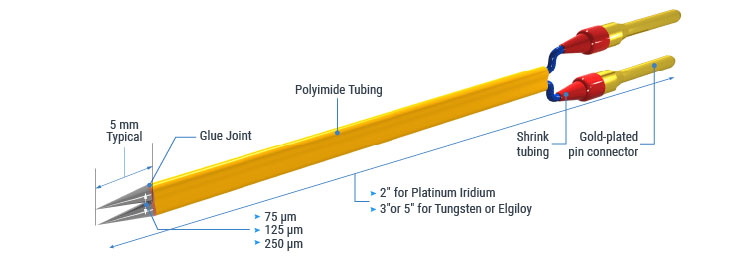Tungsten Bipolar Electrodes, Blunted Tip
Tungsten is a versatile and widely-used microelectrode material that offers a good balance between performance and cost.
| Advantages | Disadvantages |
|
|
These bipolar microelectrodes of MicroProbes are also available in Platinum/Iridium and Elgiloy (an alloy similar to stainless steel). Each electrode is etched to a fine taper and tipped using a proprietary process to a specific impedance value. We offer a variety of different tip alternatives for those that prefer a specialized electrode profile for their research. There are four different tip profiles are also available to further fine-tune your electrode selection to your particular application. The tip selection can provide subtle yet important changes to the performance of the electrode, as described below. It is recommended that first time users consider experimenting with different tip profiles to determine which works best for their recording or stimulation protocols.
Stereotrodes are excellent for bipolar stimulation studies where the current injection needs to be confined to a small localized part of the neural tissue. They have also been used for enhanced isolation of single neural elements by simultaneous recordings of multiple units on two closely spaced microelectrodes. The tip spacing is typically equal to the diameter of the electrode shaft, however, they can be specified to greater separations in most instances.
As an alternative you may consider choosing monopolar electrodes with a thin Paryclene-C coating or with Polymide tubing for insulation, or concentric electrodes.
Stereotrodes (Bipolar Electrodes), Tungsten, Blunted Tip (75 µm × 3")
|
Item |
Length |
Outside Diameter |
Tip Separation |
Impedance |
Applications |
Pkg of 10 |
|
WE3ST30.1B3 |
76 mm |
0.216 mm |
75 µm |
0.1 MΩ |
Multi Unit record. & Stim. |
|
|
WE3ST30.5B3 |
76 mm |
0.216 mm |
75 µm |
0.5 MΩ |
Single & multiunit rec. & stim. |
|
|
WE3ST31.0B3 |
76 mm |
0.216 mm |
75 µm |
1.0 MΩ |
Single & multiunit rec. & stim. |
|
|
WE3ST31.5B3 |
76 mm |
0.216 mm |
75 µm |
1.5 MΩ |
Single & multiunit rec. & stim. |
|
|
WE3ST32.0B3 |
76 mm |
0.216 mm |
75 µm |
2.0 MΩ |
Greater Selectivity & Micro. Stim. |
|
|
WE3ST32.0B3 |
76 mm |
0.216 mm |
75 µm |
2.0 MΩ |
Greater Selectivity & Micro. Stim. |
|
|
WE3ST32.5B3 |
76 mm |
0.216 mm |
75 µm |
2.5 MΩ |
Greater Selectivity & Micro. Stim. |
|
|
WE3ST33.0B3 |
76 mm |
0.216 mm |
75 µm |
3.0 MΩ |
Greater Selectivity & Micro. Stim. |
Stereotrodes - Tungsten - Blunted Tip (125 µm × 3")
|
Item |
Length |
Outside Diameter |
Tip Separation |
Impedance |
Applications |
Pkg of 10 |
|
WE3ST30.1B5 |
76 mm |
0.356 mm |
125 µm |
0.1 MΩ |
Multi Unit record. & Stim. |
|
|
WE3ST30.5B5 |
76 mm |
0.356 mm |
125 µm |
0.5 MΩ |
Single & multiunit rec. & stim. |
|
|
WE3ST31.0B5 |
76 mm |
0.356 mm |
125 µm |
1.0 MΩ |
Single & multiunit rec. & stim. |
|
|
WE3ST31.5B5 |
76 mm |
0.356 mm |
125 µm |
1.5 MΩ |
Single & multiunit rec. & stim. |
|
|
WE3ST32.0B5 |
76 mm |
0.356 mm |
125 µm |
2.0 MΩ |
Greater Selectivity & Micro. Stim. |
Stereotrodes - Tungsten - Blunted Tip (125 µm × 5")
|
Item |
Length |
Outside Diameter |
Tip Separation |
Impedance |
Applications |
Pkg of 10 |
|
WE5ST30.1B5 |
127 mm |
0.356 mm |
125 µm |
0.1 MΩ |
Multi Unit record. & Stim. |
|
|
WE5ST30.5B5 |
127 mm |
0.356 mm |
125 µm |
0.5 MΩ |
Single & multiunit rec. & stim. |
|
|
WE5ST31.0B5 |
127 mm |
0.356 mm |
125 µm |
1.0 MΩ |
Single & multiunit rec. & stim. |
|
|
WE5ST31.5B5 |
127 mm |
0.356 mm |
125 µm |
1.5 MΩ |
Single & multiunit rec. & stim. |
|
|
WE5ST32.0B5 |
127 mm |
0.356 mm |
125 µm |
2.0 MΩ |
Greater Selectivity & Micro. Stim. |
Stereotrodes - Tungsten - Blunted Tip (250 µm × 3")
|
Item |
Length |
Outside Diameter |
Tip Separation |
Impedance |
Applications |
Pkg of 10 |
|
WE3ST30.1B10 |
76 mm |
0.610 mm |
250 µm |
0.1 MΩ |
Multi Unit record. & Stim. |
|
|
WE3ST30.5B10 |
76 mm |
0.610 mm |
250 µm |
0.5 MΩ |
Single & multiunit rec. & stim. |
|
|
WE3ST31.0B10 |
76 mm |
0.610 mm |
250 µm |
1.0 MΩ |
Single & multiunit rec. & stim. |
|
|
WE3ST31.5B10 |
76 mm |
0.610 mm |
250 µm |
1.5 MΩ |
Single & multiunit rec. & stim. |
|
|
WE3ST32.0B10 |
76 mm |
0.610 mm |
250 µm |
2.0 MΩ |
Greater Selectivity & Micro. Stim. |
Stereotrodes - Tungsten - Blunted Tip (250 µm × 5")
|
Item |
Length |
Outside Diameter |
Tip Separation |
Impedance |
Applications |
Pkg of 10 |
|
WE5ST30.1B10 |
127 mm |
0.610 mm |
250 µm |
0.1 MΩ |
Multi Unit record. & Stim. |
|
|
WE5ST30.5B10 |
127 mm |
0.610 mm |
250 µm |
0.5 MΩ |
Single & multiunit rec. & stim. |
|
|
WE5ST31.0B10 |
127 mm |
0.610 mm |
250 µm |
1.0 MΩ |
Multi Unit record. & Stim. |
Common Tip Profiles:
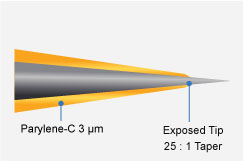
The standard tip profile features a sharp yet robust point that offers versatile performance and an effective balance between penetration and durability.
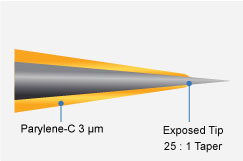
The blunted electrodes are engineered to have a more rounded, bullet-shaped tip. For many applications the blunted tip can offer superior stimulation performance.
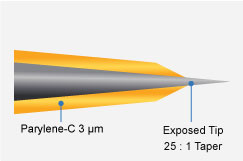
The heat-treated electrodes are intended for those investigators who must penetrate their probes through tough membranes, such as the dura mater of larger mammals.
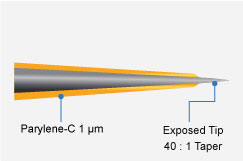
The extra-fine tip profile features a significantly sharper taper as well as a thinner insulation layer.
Also see:
Selecting the Optimum Electrode Configuration





